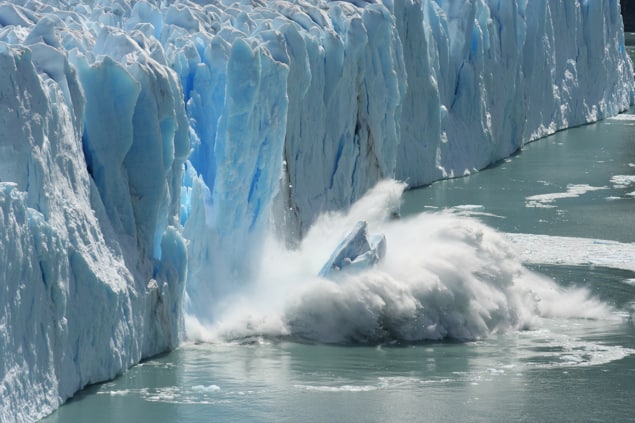
The rotation of the Earth has been affected over the past 25 years by the rapid melting of glaciers caused by climate change, according to a study done by scientists in China and Denmark. Using satellite data and modelling, the team has shown that the melting of glaciers has caused an eastward shift in the position of the true North Pole and South Pole that began in 1995.
Scientists already knew that since 2005 glacier melting has affected the location of the poles and this latest study suggests that the trend began a decade earlier. The technique developed by the team could be used to look further back in time to study the relationship between polar shifts and changes in terrestrial water distribution.
Mass distribution
The Earth spins on an axis that runs through the geographic, or true, North and South Poles. However, the precise locations of where the axis intersects the Earth’s surface changes with time. This is because the Earth is not rigid and changes in the distribution of mass, both inside the Earth and on the surface can shift the position of the poles in a phenomenon called polar drift or true polar wander.
Part of this movement is an oscillation on a timescale of about a year – caused by short-term fluctuations such as changes in ocean currents and atmospheric pressure. Scientists have also measured a slow steady shift in the poles that is believed to be associated with the rebound of parts of the Earth that were once covered by glaciers. Convection in the mantle is also believed to contribute to this long-term drift.
Amazing GRACE
In 2013, Jianli Chen and colleagues at the University of Texas, Austin showed that an eastward drift of the poles that began in 2005 is linked to melting glaciers and the associated sea-level rise. They used observations of terrestrial water (which includes groundwater) made by the Gravity Recovery and Climate Experiment (GRACE) mission, which was launched by in 2002 by NASA and the German Aerospace Center.
Grace comprised two satellites that followed the same orbit, separated by about 200 km. As the spacecraft passed over a feature on the Earth’s surface such as a mountain or glacier, the satellites experienced local changes in the Earth’s gravitational field caused by the mass of the feature. This caused tiny changes in the separation of the satellites, which were measured. This allowed GRACE to determine the shape of the Earth and monitor changes in sea level, glaciers and groundwater.
In the mid-1990s scientists spotted a significant eastward shift of the position of the poles. However, without GRACE data researchers had not been able to make the link to glacier melting. Now, Suxia Liu and colleagues at the Chinese Academy of Sciences and the Technical University of Denmark have developed a technique that uses modelling and observations from GRACE and its 2018 successor GRACE-FO to predict shifts in terrestrial water back to 1981. Other observations of glacier melting, and estimations of groundwater extraction were also used in the analysis.
Glaciers and groundwater
After accounting for known influences on polar drift, the team concluded that the main cause of the polar drift that started in 1995 is the melting of glaciers in the polar regions. However, the size of the drift cannot be explained by glacier melting alone and the team believe that there is also a contribution from the extraction of groundwater at middle latitudes – in places like California, Texas, the region around Beijing and northern India.

Wet areas getting wetter, GRACE reveals
The research suggests that the average speed of the eastward drift of the poles in 1995–2020 is about 3 mm/year – which is about 17 times faster than the average speed observed in 1981–1995. While significant, the shift is too small to be noticed in our daily lives. Indeed, Vincent Humphrey of the University of Zurich says it would change the length of a day by only milliseconds.
Scientists have been monitoring polar drift for 176 years and Liu believes that her team’s analysis techniques could be adapted to peer further back in time and determine groundwater extraction patterns in the 20th century.
The study is described in Geophysical Research Letters.



